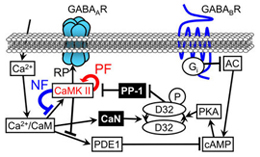Research Abstract
抑制性シナプス可塑性を動的に制御するCa2+信号の時間的文脈
Dynamic impact of temporal context of Ca2+ signals on inhibitory synaptic plasticity
2011年11月4日 Scientific Reports 1 : 143 doi: 10.1038/srep00143

記憶・学習の基盤とされる神経活動依存的シナプス可塑性は、細胞内Ca2+濃度([Ca2+]i)上昇のパターンと強く関連している。この論文では、電気生理学実験とシステム生物学的シミュレーションを組み合わせて、そうした関連が[Ca2+]i上昇の文脈によって動的に変化することを示す。小脳プルキンエ細胞では、[Ca2+]i上昇の時間積分量に応じて、Ca2+/カルモジュリン依存性タンパクキナーゼII(CaMKII)が持続的に活性化されることにより、抑制性GABAA受容体応答の長期増強(RPと呼ばれる)が起こる。しかし、RPを誘発できる2種類のパターンの[Ca2+]i上昇が組み合わさると、時間順序次第ではむしろRPの誘導はキャンセルされてしまう。305/306番トレオニンにリン酸化を受けたCaMKIIによるネガティブ・フィードバック機構が、[Ca2+]iの文脈を検出してPDE1を介するCaMKIIのフィードフォワード抑制を促す結果、RPは起こらなくなる。このような[Ca2+]i上昇の文脈に依存したシナプス可塑性の動的制御は、神経回路の時間に関する情報処理の向上に寄与している可能性がある。
- 京都大学大学院理学研究科
Neuronal activity-dependent synaptic plasticity, a basis for learning and memory, is tightly correlated with the pattern of increase in intracellular Ca2+ concentration ([Ca2+]i). Here, using combined application of electrophysiological experiments and systems biological simulation, we show that such a correlation dynamically changes depending on the context of [Ca2+]i increase. In a cerebellar Purkinje cell, long-term potentiation of inhibitory GABAA receptor responsiveness (called rebound potentiation; RP) was induced by [Ca2+]i increase in a temporally integrative manner through sustained activation of Ca2+/calmodulin-dependent protein kinase II (CaMKII). However, the RP establishment was canceled by coupling of two patterns of RP-inducing [Ca2+]i increase depending on the temporal sequence. Negative feedback signaling by phospho-Thr305/306 CaMKII detected the [Ca2+]i context, and assisted the feedforward inhibition of CaMKII through PDE1, resulting in the RP impairment. The [Ca2+]i context-dependent dynamic regulation of synaptic plasticity might contribute to the temporal refinement of
information flow in neuronal networks.

